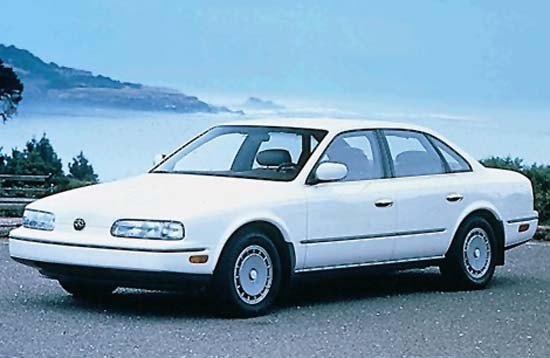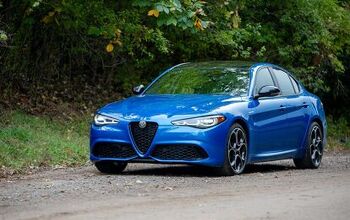90s Japanese Luxury Car Purchase Dilemma: Q45, LS 400, or RL?

Since my daily-driver ’92 Civic is about to become a much less civilized car (plus it’s finally made the transition from “somewhat rough” to “total beater,” I need to start shopping for another DD very soon. Since I’ve developed a fascination with Japanese luxury cars of the 1990s (the era before the Japanese Big Three de- Yakuza-ized the souls of their American flagships and started out-German-ing the Germans), I’ve decided it’s time I owned one. The question is: which one?
Ah, the LS 400. Plenty of them were eaten by The Crusher during the Cash For Clunkers era, but most of these big, dignified V8 sedans are still on the road today. It’s easy to picture a mid-level Nagoya loanshark making his rounds in a discreet gunmetal-gray Celsior, maybe with a couple of kneecap-busting heavies riding in the very comfortable back seat. You might not need to send your muscle out of the car to encourage timely payments from your clients, but the understated menace of the Celsior lets everyone know the option is there. Sadly, Toyota must have ditched their Yakuza consultants from their focus groups by 2000, because the LS 430 and successors were just very comfortable appliances. You can pick up a very nice LS 400 for about five grand, though it costs a bit more if you need to go VIP style with one.
The Infiniti Q45 is a much goofier car than the LS 400. Its V8 has about 40 horses over the early LS 400’s engine and Q45 buyers got variable valve timing, active suspension, and four-wheel steering. The reliability wasn’t quite up to LS 400 standards (watch out for those timing chain guide failures!) but there’s a huge helping of that Japanese love of technology for its own sake that’s sadly lacking in most of this century’s Japanese vehicles. The average age of a Q45 owner tends to be much lower than that of LS 400 owners, and the Q45 didn’t hold its value quite as well, which means most of them have had the crap beaten out of them by now. In addition, I must have a 1990-1993 model, with the strange grille-less face. I might not be able to find a low-mile, solid example, but we’ll see. I’m also tempted by the J30, but it’s just not as extreme as the early Q45.

Murilee Martin is the pen name of Phil Greden, a writer who has lived in Minnesota, California, Georgia and (now) Colorado. He has toiled at copywriting, technical writing, junkmail writing, fiction writing and now automotive writing. He has owned many terrible vehicles and some good ones. He spends a great deal of time in self-service junkyards. These days, he writes for publications including Autoweek, Autoblog, Hagerty, The Truth About Cars and Capital One.
More by Murilee Martin
Latest Car Reviews
Read moreLatest Product Reviews
Read moreRecent Comments
- Fred I would get the Acura RDX, to replace my Honda HR-V. Both it and the CRV seats are uncomfortable on longer trips.
- RHD Now that the negative Nellies have chimed in...A reasonably priced electric car would be a huge hit. There has to be an easy way to plug it in at home, in addition to the obvious relatively trickle charge via an extension cord. Price it under 30K, preferably under 25K, with a 200 mile range and you have a hit on your hands. This would be perfect for a teenager going to high school or a medium-range commuter. Imagine something like a Kia Soul, Ford Ranger, Honda CR-V, Chevy Malibu or even a Civic that costs a small fraction to fuel up compared to gasoline. Imagine not having to pay your wife's Chevron card bill every month (then try to get her off of Starbuck's and mani-pedi habits). One car is not the solution to every case imaginable. But would it be a market success? Abso-friggin-lutely. And TTAC missed today's announcement of the new Mini Aceman, which, unfortunately, will be sold only in China. It's an EV, so it's relevant to this particular article/question.
- Ajla It would. Although if future EVs prove relatively indifferent to prior owner habits that makes me more likely to go used.
- 28-Cars-Later One of the biggest reasons not to purchase an EV that I hear is...that they just all around suck for almost every use case imaginable.
- Theflyersfan A cheaper EV is likely to have a smaller battery (think Mazda MX-30 and Mitsubishi iMEV), so that makes it less useful for some buyers. Personally, my charging can only take place at work or at a four-charger station at the end of my street in a public lot, so that's a crapshoot. If a cheaper EV was able to capture what it seems like a lot of buyers want - sub-40K, 300+ mile range, up to 80% charging in 20-30 minutes (tops) - then they can possibly be added to some lists. But then the issues of depreciation and resale value come into play if someone wants to keep the car for a while. But since this question is asking person by person, if I had room for a second car to be garaged (off of the street), I would consider an EV for a second car and keep my current one as a weekend toy. But I can't do a 50K+ EV as a primary car with my uncertain charging infrastructure by me, road trips, and as a second car, the higher insurance rates and county taxes. Not yet at least. A plug in hybrid however is perfect.


































Comments
Join the conversation
The Q is a sweet ride on the cheap. Fast, handles surprisingly well (get Tokico Blue shocks to really improve the cornering for very reasonable money) and is very comfy. Downsides? Not fun to fix, the timing chains NEED to be addressed, the trannies are fragile at high miles, the driveshafts wear out and need new rubber bushings, and you should avoid the active suspension/four wheel steering models at all costs if you want to stay out of bankruptcy. It also sucks fuel at a rather alarming rate; mid teens in the city is good, YMMV, I got between 8.5 and 12 mpg in downtown Montreal with mine, but a decent 28-30mpg on the highway (Imperial units). An 85 litre tank made for a long cruising range but a minor heart attack at every fillup. It felt more sprightly and fun than a comparable BMW or Merc of that era, if not as well screwed together. My point of comparison was a 92 420SE W140 which felt like the proverbial rolling bank vault. I drove an early LS; my impression was extremely boring and slow for a V8, but surprisingly tight considering how well used and abused that example was. The Q is the fun choice by far, but it isn't the best built. 1990-93 is the best Q motor wise. That was the VH45 series which was seriously overbuilt, aside from the chain tensioners. They had sodium filled valves, polished conrods and crank, much stronger internals, and a higher output than the later cheaper-to-build 4.1L. It was a cost-no-object sort of engine that was replaced by a bean-counter friendly V8 in the later models. I miss the fun of the Q, but I don't miss the fuel bill or the many repairs I had to do to it (or that nagging driveline vibration that wasn't getting any better..).
Hey hey hey! Zillion postings. I am a new member commenting on CC, and my wife and I have had nothing but Lexus 8s for the last 17 years. Does that make us car snobs?